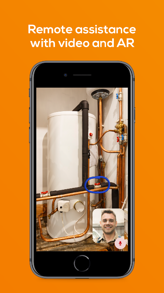Service Productivity In The Age Of Working Remotely
By Jason Morjaria, Commusoft

The concept of working from home is on everyone’s minds these days, under the guise of offering an equitable life/work balance. However, it is easy to build an argument for, say, a software provider or a marketing agency to work from home, but field service employees — whether they’re technicians, admin or managers — have a harder time adapting to these circumstances. After all, so much of their work depends on carefully optimized routes between office premises, inventory locations, and service locations, that even disregarding the field technicians themselves, moving the office to a “work-from-home” status is a major undertaking.
The main complaint regarding working-from-home is that field service productivity will suffer major setbacks, as the following tasks become more complex affairs:
- Nurturing customer relationships
- Efficient communication between admin and technicians
- Aligning multiple teams on the same schedule
Many of the challenges stem from a lack of suitable tools to help with remote business management. Even in extreme circumstances, field technicians, whether they specialize in plumbing, HVAC, fire & security, or any other service, will still be in demand as key workers. This has led to the belief that preventive remote working measures are unnecessary. However, we live in a world where more and more employees value flexibility and where legislation changes to demand digital security for any business storing customer information.
“Preventive action is better than reactive” is something any field specialist can agree on and to this end, we’ve investigated the following technologies that can aid companies researching how to work remotely and manage service technicians on-field:
Real-Time Scheduling With Automated Customer And Technician Notifications
Without exception, a field technician’s job involves trips to the office, whether it’s to deliver paperwork, get a sign-off to take items out of storage, or simply sign in and out of the job. It must be said: these trips are a fixture of wasteful communication and scheduling processes.
Why wasteful? Because the time spent driving is billable, the fuel and truck maintenance costs add up in the long run, and the risk of misplacing or misreading customer data looms large on admin staff that is already under stress.
A business that wants to be prepared for any situation will spend time researching the best scheduling tools that fit their work and their team. Scheduling, whether simply digital or fully automated, can increase field service productivity and employee performance dramatically, but it’s not done simply by using Google or Outlook Calendars.
The technology has advanced to a point where driving around with stacks of paper is not necessary anymore, especially with admin and technicians becoming more accustomed to smartphones, cloud storage, and other gadgets. Without realizing it, employees are organically moving toward a remote-friendly work pattern.
The risk here is letting processes form on their own, without any strategy behind their implementation. This way, you’ll see techs taking photos of documents and sending them via WhatsApp to the office manager’s personal number, without realizing that they might be sharing private customer information via devices that are not associated with the company nor properly secured. At the same time, employees will find other disorganized methods of making scheduling more transparent on their own and form habits that can be difficult to break.
According to Philip Welch, an expert in real-time route optimization and scheduling, “The key requirement to use real-time route optimization is to automate communication between your field workers and the central planning engine – so you know where your workers are, what jobs they’ve already completed, and you can send them new jobs.”
Investing in an intelligent scheduling tool that fits both your business’ size and work values will eliminate these unproductive practices. It also will reduce the unnecessary paperwork that comes with managing a company and this applies regardless of whether you want to make remote work a permanent fixture or temporary alternative to the status quo.
Remote Support And Remote Diagnostics
How do you keep customers happy when you’re trying to prioritize emergency jobs? Simply refusing them or postponing their appointment until the situation improves is far from ideal, as those are not only leads lost for now, they’re leads lost forever. The chances of the customer retracing their buyer’s journey and reaching your company, then engaging with it again are very slim now that they’ve been turned away, regardless of what the context is.
The happy medium is a remote diagnosis, where your technicians—as the experts—can assess the situation beforehand. More often than not, customers (domestic and commercial alike) are not able to describe the issue in more detail, other than “my hot water isn’t working” and as any technician will know, there could be a whole series of things wrong with the boiler. The problem is that only a handful of those problems require an actual truck roll and others are easy fixes that even an inexperienced homeowner could resolve themselves.
An augmented reality (or AR) tool can aid this scenario, saving businesses from lost jobs and unsatisfied customers. With recent developments in technology, particularly Apple’s AR Kit, there are a few scenarios where an AR mobile application can be deployed and help customers soft-fix small issues, without wasting time and fuel for technicians. Below is a mock-up of how this tool would look like in real life; the technician can see what the situation is then direct the customer by hand, drawing on the image and communicating via video call.

AR tools also can be a solution for techs who encounter a novel appliance or system, where they’re simply unsure of what to do next. Remote diagnosis technology can help them contact other technicians, managers in the office, or those working remotely, and enable them to present a problem whilst also helping them to find a solution on the spot. This way, it’s not necessary to have back-and-forth phone communications that leave no accountability trail, and which also keeps people waiting.
The matter at hand is not that these tasks are impossible to get done without a dedicated tool, but the gains in time, employee wellbeing, and customer satisfaction far outweigh the investment. Remote support and remote resolutions can lead to an increase in service productivity, which is only to be expected as using a tool that’s more suitable to the situation yields better results.
Professional Chat Tool
An overlooked consequence of remote working is the impact it has on team communication. Having no contact with other employees can lead to alienation from the team and feelings of loneliness and disconnect. Employee wellbeing is a top indicator of high productivity and ensuring they have the tools to be at ease even in an unusual context is by far one of the most important investments a company can make.
This is all the more important as, according to a Social Policy and Society journal study, remote workers are more likely to complain of having difficulties separating work life and home life, as they now take place in the same space. Additionally, they also take fewer sick days and daily breaks which might boost service productivity in the short term but have negative consequences in the long run.
There’s no doubt that chatting has become a staple of everyday life so it is to be expected that, even with video calls and the aforementioned AR technology at hand, some employees might still feel more comfortable in casual conversation if it’s by text. Problems arise when informal communication tools are used in formal environments, like work, an issue that is aggravated by remote offices. Similar to the study’s finding, the line between personal and professional life becomes blurred and the risk of inappropriate situations that disturb employee performance can increase.
For example, many field service managers use WhatsApp as a communication tool, going as far as to organize groups for projects or specific tasks. But in a technician’s contact list on WhatsApp, there might be dozens of friends and family members mixed in with the company conversations. The risk of exposing private customer information to people outside the organization by accident is high, as well as everything that’s associated with using the same device for personal activities and work.
Professional chat software, like Slack, Kipwise, and others, can help employees compartmentalize their work activities from their personal ones. These productivity tools also come with the benefit of being designed for a niche market rather than for the general public and, therefore, have many features to enable better team management and communication. Add-ons like emojis and short videos also support a friendly team environment and encourage a remote version of watercooler conversations which shouldn’t be underestimated when it comes to spurring creativity and innovation.
At the same time, if you decide to invest, it’s best to look for a provider that specializes in the field service industry. This will help if you want to integrate the chat software with your current system or inform you whether you should look into upgrading to a complete field service management software that includes chat as a feature.
The Cost Of Investing In Remote Working Tools Versus The Cost Of Not Having Them When Needed
These technologies are part of a greater effort of software providers helping to set up field service companies who want to ditch paper and start automating mundane and repetitive tasks that plague their services. This way, field service companies can future proof their processes.
As more and more players have come on to the scene, the cost of development has, fortunately, become accessible even to the smallest of businesses and can help a small business to compete more efficiently with the giants in their respective industries. The condition of entry is now more about whether a business is hungry for growth and ready to make positive changes.
Between a low initial cost of implementation and the potential for increased productivity and profit, digital tools are essential for field service companies researching how to work remotely. As recent events have pointed out, flexibility is key in preventing loss of business and customers. Consequently, the money saved by not investing in new tech is far outweighed by the losses of not being able to do business in circumstances where the office is inaccessible.
All in all, technologies like AR and automation are here to make things easier for field service businesses and open up the sector to even bolder advancements. For more details on the real-life implementation process of these concepts, visit www.commusoft.us.
